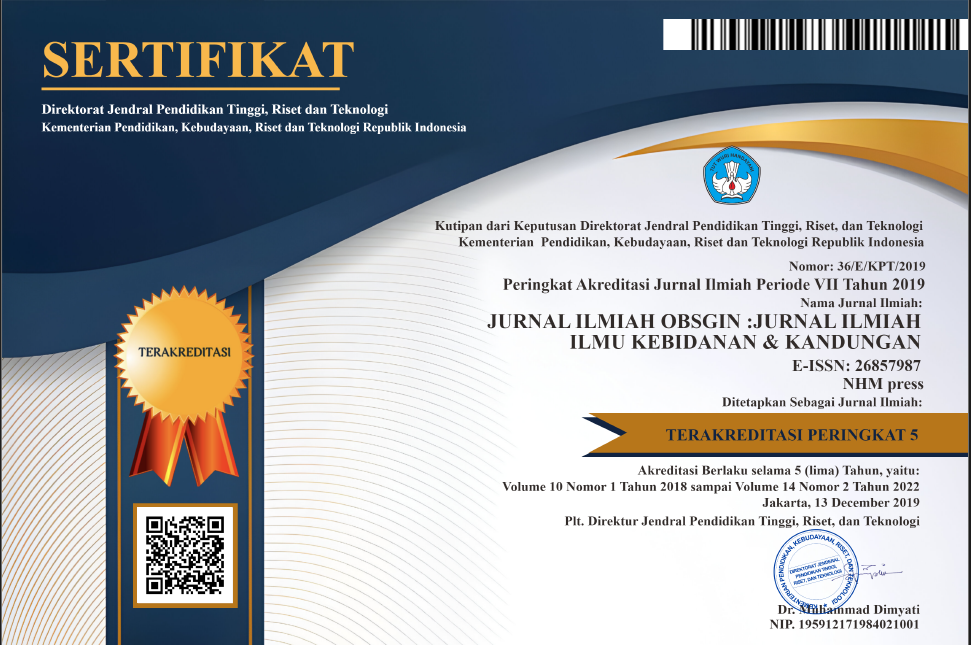METODE PEMICUAN DALAM UPAYA MENINGKATKAN BUDAYA PEMBERANTASAN SARANG NYAMUK (PSN) PADA MASYARAKAT
Abstract
The purpose of this development is to produce an educational model "Triggering PSN Mobile," while the specific objectives are to describe the development process, determine feasibility, describe the stages, and find out the effect of the educational model for eradicating mosquito nests on the knowledge, attitudes, and behavior of the community. This research method is quantitative research with a research and development (R&D) design. This research uses a one-group pretest and posttest design. The focus of this study is to test the effectiveness of the educational model with the PSN reminder application in increasing the culture of eradicating mosquito nests in the city of Jambi. The variables studied include knowledge, attitudes, and behavior. The results of this study resulted in the PSN Mobile Triggering educational model, which is a field triggering model followed by Android-based triggering, which has been declared feasible after going through the validation stages of 100% health promotion experts, 94.55% IT experts, 92% educational technology experts, and 80 practitioners. % and 93.85% one-on-one trials, 95% small group trials, and 96% large group trials. The PSN Mobile Triggering Product is effective in increasing the knowledge, attitude, and behavior of the jumantik rumah to 100% in the implementation of mosquito nest eradication. The conclusion obtained is that the educational model is feasible and effective to use to increase the knowledge, attitude, and behavior of Jumantik Rumah in carrying out the eradication of mosquito nests.
References
Badan Pusat Statistik. (2022). Badan Pusat Statistik (pp. 335–358). https://doi.org/10.1055/s-2008-1040325
Chandra, E. (2019). Pengaruh Faktor Iklim, Kepadatan Penduduk dan Angka Bebas Jentik (ABJ) Terhadap Kejadian Demam Berdarah Dengue (DBD) di Kota Jambi. Jurnal Pembangunan Berkelanjutan.
Chandra, E., Johari, A., Syaiful, S., & Fahri, S. (2021). Alternatives to Improve Mosquito Eradication Behavior: A Systematic Review. Journal of Research Development in Nursing and Midwifery, 18(2), 53–59. https://doi.org/10.29252/jgbfnm.18.
Dikha Pistiyati Ramdani. (2016). Difusi dan adopsi inovasi “pemicuan stop jentik” sebagai upaya tindakan pencegahan demam berdarah (db) (Studi Deskriptif Kualitatif Difusi Inovasi dan Adopsi Inovasi Teknik “Pemicuan Stop Jentik” dalam memberikan. UNS.
Fahri, S., Yohan, B., Trimarsanto, H., Sayono, S., Hadisaputro, S., Dharmana, E., Syafruddin, D., & Sasmono, R. T. (2013). Molecular Surveillance of Dengue in Semarang, Indonesia Revealed the Circulation of an Old Genotype of Dengue Virus Serotype-1. PLoS Neglected Tropical Diseases. https://doi.org/10.1371/journal.pntd.0002354
Farasari Rizky, A. M. (2018). MODEL BUKU SAKU DAN RAPOR PEMANTAUAN JENTIK DALAM MENINGKATKAN PERILAKU PEMBERANTASAN SARANG NYAMUK. JHE (Journal of Health Education). https://doi.org/...
Frida, N. (2020). Mengenal Demam Berdarah Dengue. Alprin.
Hadi, C., Sugiarto, K.Y, M., & Rahmah, Z. (2012). Pengaruh Penyuluhan Kesehatan dengan Media Komik Tanggap DBD Terhadap Peningkatan Pengetahuan dan Sikap Tentang Pencegahan DBD di SDN Banjarejo Ngadiluwih Kabupaten Kediri. Prosiding Semnas Competitive.
Iin, N. K., & Hidaya, N. (2020). Keterkaitan Antara Kondisi Lingkungan Dan Perilaku Masyarakat Terhadap Keberadaan Vektor Demam Berdarah Dengue (DBD). Journal of Borneo Holistic Health, 3(2), 75–85.
kasus DBD 2021 Kota Jambi. (n.d.).
Kemenkes RI. (2017). Peraturan Menteri Kesehatan Republik Indonesia Nomor 67 Tahun 2016 Tentang Penanggulangan Tuberkulosis. In Kementerian Kesehatan.
Kusuma, W. D. (2021). Gambaran Bionomik Nyamuk Aedes Aegypti Di Kelurahan Perumnas Way Kandis Kota Bandar Lampung. Ruwa Jurai: Jurnal Kesehatan Lingkungan, 12(2), 95–101.
Mangidi, M. A. G. T., Sunarsih, & Jahadipraja, E. A. (2019). Pengaruh pemicuan terhadap angka bebas jentik (ABJ) di Kelurahan Rahandouna Kota Kendari. Al-Sihah: Public Health Science Journal, 11(2), 134–142.
Murray, N. E. A., Quam, M. B., & Wilder-Smith, A. (2013). Epidemiology of dengue: Past, present and future prospects. In Clinical Epidemiology. https://doi.org/10.2147/CLEP.S34440
Palaniyandi, M. (2021). New, Emerging, Re-Emerging Tropical Infectious and Non-Communicable Diseases Persistent to the Climate, Landscape, and Environmental Changes on the Grounds of the Urbanizations, Industrializations, and Globalisation. International Journal of Environment and Climate Change, 11(11), 32–46.
Prabowo, M. (2020). Metodologi Pengembangan Sistem Informasi. LP2M Press IAIN Salatiga.
Prasetya, W. A. (2014). Pengaruh Pemicuan Masalah Demam Berdarah Berbasis Masyarakat Terhadap Pengetahuan, Sikap, Dan Perilaku Pencegahan DBD Pada Kader PKK Di Kelurahan Sesetan Tahun 2013. Community Health.
Silvia, F., Risnita, & Syaiful. (2015). Development of Rubrics for Creative Thinking Skill in Solving Problems in Mathematics for 8-Grade Students of SMP at Attaufiq Jambi. Edu-Sains.
Sugiyono, S., & Darnoto, S. (2017). PENGARUH PELATIHAN PENCEGAHAN DEMAM BERDARAH DENGUE (DBD) TERHADAP TINGKAT PENGETAHUAN DAN SIKAP SISWA DI SDN WIROGUNAN I KARTASURA KABUPATEN SUKOHARJO. Jurnal Kesehatan. https://doi.org/10.23917/jurkes.v9i2.4594
Tresnawati, D., & Fauzi, A. (2017). Pengembangan Aplikasi Edukasi Pencegahan Penyakit Demam Berdarah Berbasis Android. Jurnal Algoritma, 14(2), 298–304.
Tribun. (2023). Dinkes-Kota-Jambi-dr-Rini-Kartika.
Widyanto, A. M. (2013). Statistika Terapan Konsep dan Aplikasi dalam Penelitian Bidang Pendidikan Psikologi dan Ilmu Sosial lainnya. PT Elex Media Komputindo Jakarta.
Wowor, R. (2017). Pengaruh Kesehatan Lingkungan terhadap Perubahan Epidemiologi Demam Berdarah di Indonesia. E-CliniC. https://doi.org/10.35790/ecl.5.2.2017.16879











